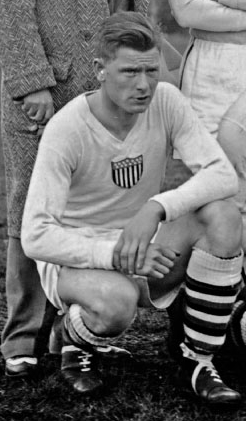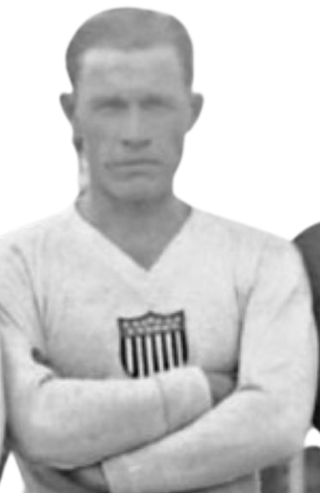Related Research Articles
Bethlehem Steel Football Club (1907–1930) was one of the most successful early American soccer clubs. Known as the Bethlehem Football Club from 1907 until 1915 when it became the Bethlehem Steel Football Club, the team was sponsored by the Bethlehem Steel corporation. Bethlehem Steel FC played their home games first at East End Field in Bethlehem, Pennsylvania, in the Lehigh Valley, then later on the grounds Bethlehem Steel built on Elizabeth Ave named Bethlehem Steel Athletic Field.
Fall River Rovers were a United States soccer club, based in Fall River, Massachusetts. They won the 1888 and 1889 American Cups as well as the 1917 National Challenge Cup. In 1921 Rovers were disbanded and a new team, Fall River United were formed to enter the newly established American Soccer League.

James Brown was a Scottish American soccer player who played for the United States men's national soccer team at the 1930 FIFA World Cup, scoring the only goal of the American team in their 6–1 semi-final loss to Argentina. He began his career in the American Soccer League before moving to England and then Scotland. After retiring from playing, he coached at the youth, senior amateur, and professional levels. He was inducted into the U.S. National Soccer Hall of Fame in 1986.
Robert Millar was a soccer player who played as a forward and the coach of the United States national team at the 1930 FIFA World Cup. During his at times tumultuous Hall of Fame career, he played with over a dozen teams in at least five U.S. leagues as well as two seasons in the Scottish Football League. He finished his career as a successful professional and national team coach.

Alexander Lochian Wood was a Scottish American soccer defender. Wood began his club career in the United States before moving to England in the early 1930s. He also played in all three U.S. games at the 1930 FIFA World Cup. He is a member of the National Soccer Hall of Fame.
The Brooklyn Robins Dry Dock were an American soccer team which took its name from the workplace it represented. The dock was part of the Todd Pacific Shipyards in Brooklyn who formed the professional soccer club in 1918 to play in the National Association Football League. Robins played until the league folded in 1921. Robins best finish was third in 1920 and 1921, but won the 1921 National Challenge Cup.
Neil G. Clarke(sometimes listed as Clark) was a Scottish American soccer player who began his career in the Scottish Football League before migrating to the United States. He played in both the National Association Football League and American Soccer League. In 1916, he played in the first two U.S. national team games.
Thomas "Tommy" or "Whitey" Fleming was a Scottish American soccer outside forward who began his career in Scotland and finished it in the United States. During his Hall of Fame career, Fleming won five American Cups, four National Challenge Cups and at least eight league titles.
The Southern New England Soccer League was a semi-professional soccer league based in New England which was established in 1914 and collapsed in 1921. During its short existence, it featured some of the top teams in the northeast United States. Dissatisfaction with league mismanagement led to the end of the SNESL in 1921 as several teams moved to the newly created American Soccer League.
Tebo Yacht Basin was an amateur U.S. soccer team sponsored by the Tebo Yacht Basin company of Brooklyn, New York. It had a brief impact on the U.S. soccer scene from 1918 to 1921.
Fore River was an amateur U.S. soccer team which had its origins as the Fore River Shipbuilding company team of Quincy, Massachusetts.
Babcock & Wilcox was a U.S. soccer team which had its origins as the Babcock & Wilcox company team of Bayonne, New Jersey. It spent five seasons in the National Association Football League and finished as runner-up in the 1918 American Cup.
Abbot Worsted Company was at one time the largest producer of carpet yarns in the world.
Jack Kershaw was an English soccer center forward who began his career in England and ended it in the United States. He was born in Lancashire, England. He played at least two seasons in the Southern New England Soccer League and two in the American Soccer League before coaching professionally and collegiately.
Peter Sweeney was an early 20th-century Scottish-American soccer forward who began his professional career in Scotland before playing in the National Association Football League and American Soccer League in the United States.
Fairlawn Rovers was a U.S. soccer team which existed from at least 1918 to at least 1949. It was based in Fairlawn, Rhode Island.
Frank McKenna was a Scottish football wing forward who began his career in Scotland before playing eight seasons in the American Soccer League.
Frederick "Chiddy" Pepper was an English footballer who played as an inside forward. Born in Netherfield, Nottinghamshire, Pepper received a basic education before finding vocation as a fireman on the local railway. Joining Notts County F.C. in 1908 aged 21, he found little success playing in the English Football League and subsequently emigrated to Canada in 1913. Settling in Hamilton, Ontario, Pepper was scouted by industrialist Charles M. Schwab from local team Hamilton Lancashire and joined his Bethlehem Steel F.C. in 1914, an important club in the infancy of organized association football in the United States.

Saylesville is a village and historic district in Lincoln, Rhode Island.
The American Soccer League, established in 1921, was the first of four different professional soccer sports leagues in the United States to use the ASL name. It was formed by the merger of teams from the National Association Football League and the Southern New England Soccer League. For several years the ASL's popularity rivaled the popularity of the National Football League. Disputes with the United States Football Association and FIFA, as well as the onset of the Great Depression, led to the league's collapse in spring 1933.
References
- ↑ October 22, 1920 New York Times
- ↑ "Sayles Wins The Times Cup". (April 11, 1921). Daily Evening News, p.5 col.2